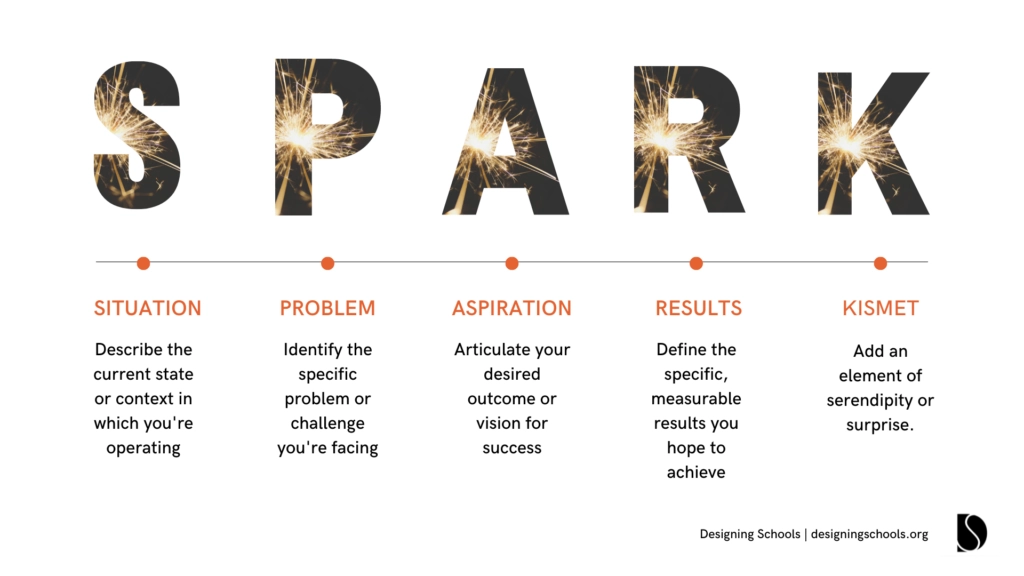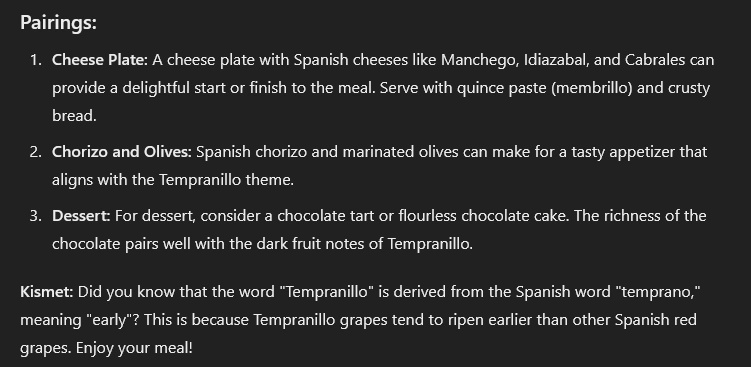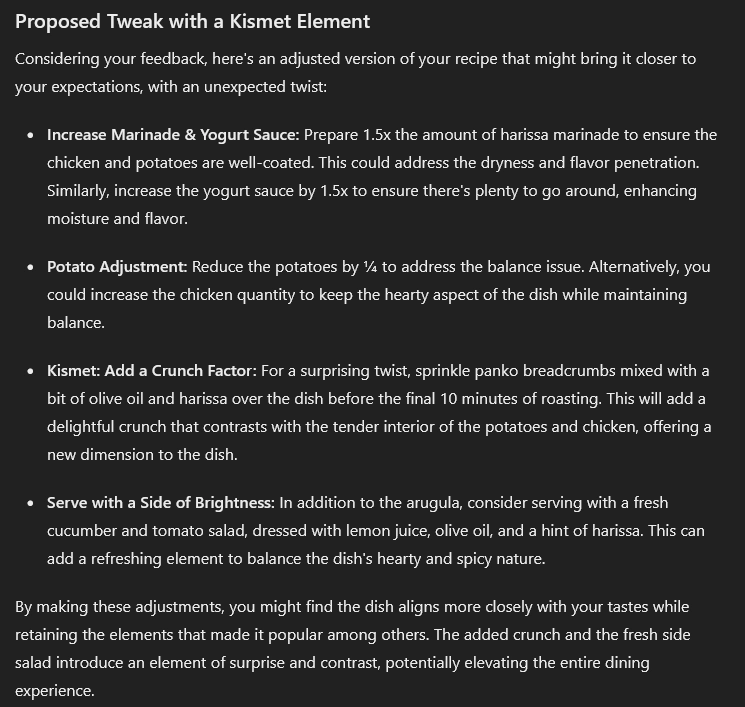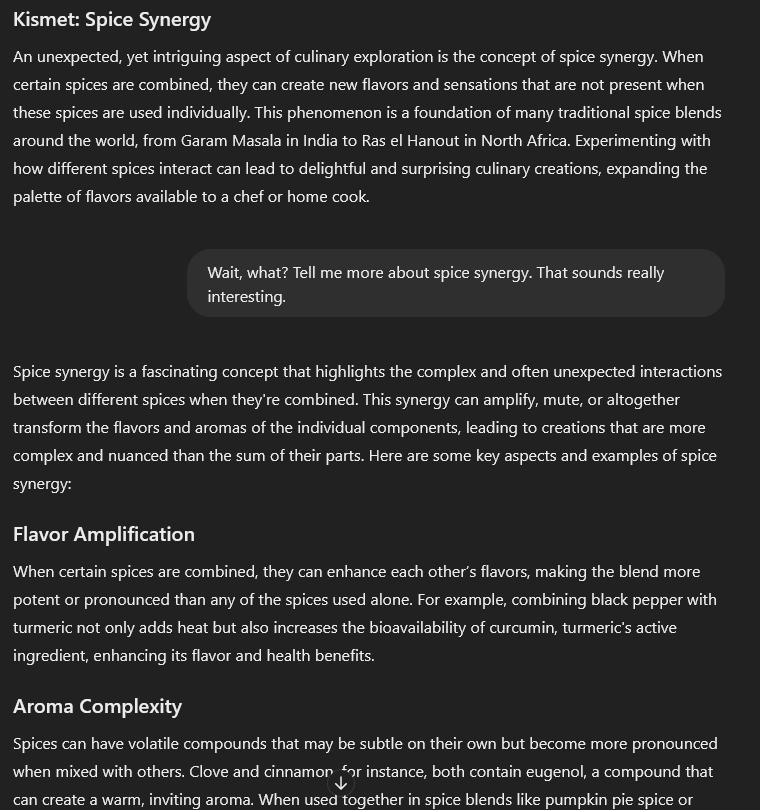What type of content do you primarily create?




Creativity is a tricky thing, even for humans. Scientists are still trying to understand the elements that lead to creativity, so being able to get AI to be truly creative is a tall order.
Which is why a new prompt framework jumped out at me: the SPARK framework, created by entrepreneur Dr. Sabba Quidwai. It’s an acronym, but the last letter was what really appealed: K stands for Kismet. This piece of the framework is designed to make a large language model like ChatGPT imitate the moments of serendipity that can lead to real human creativity, and I tried it in my own ChatGPT instructions with impressive results.
TL;DR: the Kismet ChatGPT prompt
You can either add this to an individual prompt or to your custom instructions so it appears in every output:
Kismet: Include something surprising or unexpected in your responses. This should be related to the question but it should be new, different, and unique. Indicate this surprising element with "Kismet". The Kismet fact should be adjacent to the main topic and add an interesting twist or piece of information to enrich the response.
Why Kismet?
Quidwai's background is in education and design thinking, so it was through this lens that she created the SPARK framework, which stands for Situation-Problem-Aspiration-Results-Kismet. The framework emphasizes ‘prompting the human before the machine,’ ensuring our unique perspective guides AI-generated solutions. “It starts with empathy,” she said. “It’s designed to be an empathy interview that prompts the human before the machine.”

"[Kismet] came from my experience during the pandemic," Quidwai said. "One of the things that I missed the most, that I never even realized mattered as much as it did, was the serendipity of a conversation." She said a comment from someone in conversation can give us an "aha moment" and cause us to widen our perspective.
Quidwai wanted to transfer this powerful experience to using AI tools. "We can mirror and mimic some of the qualities that we benefit from during conversations with people with our AI tools." Instead of giving answers, the tools provide suggestions, which she said in turn "provokes your own thinking to go deeper down whatever path."
That idea is backed up by research into creativity, as well as anecdotal comments from creative people in fields ranging from science to screenwriting and music to entrepreneurship.
Surprise and serendipity as triggers for creativity
Most creative people will tell you that both surprise and serendipity help ignite creative thinking. I’ve definitely noticed that in my own work.
Joseph L. Goldstein writes for the Lasker Foundation that “Anything that is truly creative produces surprise, and surprise produces creativity by stimulating curiosity, which triggers a search to reveal the mystery of things unknown.”
But it's not just a gut hunch. Research into creativity has found this to be true experimentally. There are two distinct features that impact creativity, and both of them have to do with disrupting your current way of thinking: Unusual but normal experiences, like experiencing new cultures, and awe-inspiring experiences, like experiencing exceptional natural phenomena.
During problem solving, the researchers say we typically rely on our existing knowledge and usual thought patterns, so we end up with conventional and stereotypical solutions. But unusual experiences push us out of our regular patterns of thinking and result in more creativity.
Serendipity—making fortunate discoveries by accident—is also important to creativity. As Isaac Asimov puts it, "The most exciting phrase to hear in science, the one that heralds new discoveries, is not 'Eureka!' but 'That's funny...'"
Surprise and serendipity are not quite the same thing, although they both involve adding an unexpected element to your work. I think of it like this: a surprising element might be interesting, but it's that serendipity—when the surprising element comes at just the right time—that it can really push a creative project forward.
So, by adding the Kismet element to your prompts, you can deliberately add a surprising element to your results. And with luck, that element could result in the serendipity you need.
How to use Kismet in your ChatGPT prompts
Quidwai typically types out that extra Kismet request by hand (which can get repetitive pretty fast). Thankfully, there’s no law on how you add Kismet. You can store a standard Kismet request in your custom instructions, tack it on at the end of a prompt, or even invent your own spin on Kismet for your specific project. Experiment with what feels right.
Since I tried it out, I found it most useful to add it to my custom instructions—that way I don't have to remember to add it each time. Since I've added it, it’s become the part of the results I look forward to reading the most. Sometimes I even skip down to read it first.
Here's the Kismet custom instruction I use:
Kismet: Include something surprising or unexpected in your responses. This should be related to the question but it should be new, different, and unique. Indicate this surprising element with "Kismet". The Kismet fact should be adjacent to the main topic and add an interesting twist or piece of information to enrich the response.
My Kismet results
Often, my Kismet custom instruction gives me a nice did-you-know type of factoid related to my query. They're neat, and often give me a little happy boost around what I'm working on.

…Even if what I'm working on is sort of boring, like learning about different kinds of shareholder agreements. In fact, I especially appreciate them when I'm working on something more tedious.

ChatGPT doesn't interpret the custom instructions the same way every time—sometimes it will include a Kismet element within the main part of the response.
For instance, in this conversation, it added a twist to the recipe that was an extra suggestion outside of my main query, which was to help me fix a recipe I wasn't keen on after my first attempt.

It's important to note, though, that because AI tools can hallucinate, it's always a good idea to double check the information, if the factoid it gives you is important to your work. So far, I've had good luck with accuracy of my Kismet output using ChatGPT-4o, but your mileage may vary.
A result that changed my life (or at least my cooking)
So far the Kismet elements I've shown you have been interesting but didn’t exactly wow me.
But when I use Kismet regularly, every once in a while the serendipity hits: the Kismet element will generate something so striking that I just can't help but follow it down the rabbit hole.
My first experience with this was when I was making recipes with ChatGPT, something I do almost every day. It told me about a concept called “spice synergy,” which I’d never heard before.

The Kismet element told me that combining spices can create new flavors and aromas not present in each individual element. I knew this ambiently from taking my first level Sommelier course a couple of years ago, where pairings were an essential part of the course. But interestingly, I never really thought about it in terms of spices.
When I researched it, I mostly found academic articles about biology with no reputable sites talking about the actual flavor impact, so I asked my friend, restaurant owner and chef, Shaun Hanna about it, who told me this is indeed well-known to chefs and food scientists.
"It’s a bit like music, a note is just a note, but a chord can have resonances and harmonics that amplify [and] stir deep emotional responses in the listener. Flavor is much the same," he said.
This Kismet element has completely shifted how I think about combining spices in my dishes. Not only that, but I couldn't even find any articles to read about it—maybe I should write one.
I’m pretty sure I’d never have stumbled on this concept without the Kismet element in my prompts. But now that I have, it’s totally changed how I think about combining flavors.
Another creativity prompt—the Impossible
Kismet is cool, but sometimes even ordinary creative pushes are no match for a particularly ambitious project, so you need to really push the boundaries.
Luckily, another element is emerging as a fresh creativity catalyst: the Impossible. Though research is early, there’s preliminary evidence that “inherent cognitive disruption”—or in other words, impossible experiences—“are an important driver for creative thinking.” If you’re curious about more ways to push your prompts beyond everyday thinking, check out these 19 prompt structures for more inspiration.
The researchers tell us that "people experience the seemingly impossible when they encounter an event that they believe cannot occur." This can take a range of forms, such as bizarre dreams, the fantasy play that most children engage in, or even magic tricks.
But for AI tools, I've found it to be a real benefit to thinking wildly ambitiously.
I tried it when working on a concept for a narrative video game, and in this extremely open-ended creative space, I found that it had much more interesting ideas compared to the Kismet suggestions, although both were useful.
Here's my custom instruction for the Impossible:
Impossible: After every prompt, give me a description of something impossible that has something to do with the topic of the prompt. Make it wildly creative but still relevant to the topic.
You could also substitute the term "impossible" for a word closer to the style you're after, like "dreamlike", "bizarre", "unexpected" etc.

I even got some pretty good output when I was working on less creative work, such as preparing for a strategic planning session.

However, when I used it working on a science fiction story—one I'd already more or less mapped out, the suggestions tended to be less useful. My guess is that the Impossible Insights were too much in conflict where I already knew the story was going to go, and they came across as annoying.
I ended up keeping the impossible in my custom instructions anyway—and it took less than a week for it to give me a Wow moment that completely changed one part of the story I hadn't quite figured out.
Other ways to introduce serendipity
One of the most important questions Quidwai asks is "How do we become more ambitious with our own ideas?" I loved that, and I really think adding the surprising element to your AI outputs can help you do that.
The nice thing about Kismet is that you can customize it for any lens you want to. Here are a few I tried:
- I'm a fan of Eno and Schmidt's Oblique Strategies card deck, which I wrote about in relation to prompting and so I asked ChatGPT to draw a card after each response and apply it to the output.
- At the recent Berkshire Hathaway Shareholder Meeting, Warren Buffett suggested that they think about business on centuries-long timescales. So I asked the tool to add a comment on the response one century out to consistently think about that perspective.
- I always want examples, so I tried asking for examples from literature and history that had to do with the topic I was working on, and it turned up some pretty interesting stuff I didn't know about.
- Related, as an avid science fiction reader and writer, it's always interesting to know how science fiction has explored and imagined a topic, and that can give you an interesting view into the past.
- Systems Thinking is something I'm new to, so I also thought it was interesting to add a systems thinking element to the output (How does viewing the topic as part of a larger system reveal new insights?)
I hope Kismet will push your work to new creative heights—it certainly has for me.
Frequently asked questions
What is Kismet in ChatGPT instructions?
Kismet is a creative twist you add to your ChatGPT prompts. By asking ChatGPT to include a “Kismet” element, you invite a surprising or unexpected fact related to your topic. This helps spark new ideas and generate fresh perspectives.
How do I include Kismet in my custom instructions?
First, open your ChatGPT settings and add a brief line telling ChatGPT to include a Kismet element in its replies. Be clear that you want a surprising or adjacent fact highlighted as “Kismet.” Once set, every new answer can contain that unexpected snippet to spark creativity.
What if the Kismet fact is inaccurate or irrelevant?
AI sometimes invents details or strays off-topic, even in a Kismet section. If you get a fact that doesn’t make sense, ask ChatGPT to double-check its sources or refine the Kismet element. Always verify any crucial information independently.




























%201.svg)








%20(1).JPG)
